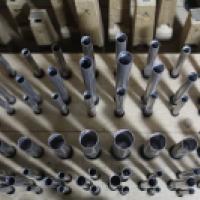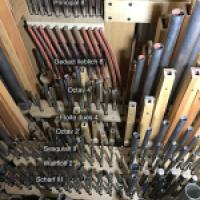The specification gives the name of the stop and the pitch level of the rank by giving the length of the longest pipe (lowest note). 8’ pitch is the normal pitch of the piano. The number of divisions and stops varies from instrument to instrument. For example, the Cornell Baroque Organ has 3 divisions and 31 stops.
Cornell Baroque Organ Specification
| Hauptwerk | Rückpositiv | Pedal |
|---|---|---|
| 1) Principal 8′ | 1) Principal 8′ | 1) Principal 16′ |
| 2) Quintadena 16′ | 2) Gedact Lieblich 8′ | 2) Octav 8′ |
| 3) Floite Dues 8′ | 3) Octav 4′ | 3) Octav 4′ |
| 4) Gedact 8′ | 4) Floite Dues 4′ | 4) Nachthorn 2′ |
| 5) Octav 4′ | 5) Octav 2′ | 5) Rauschpfeife II |
| 6) Viol de Gamb 4′ | 6) Sesquialt II | 6) Mixtur IV |
| 7) Spitzflöit 4′ | 7) Waldflöit 2′ | 7) Posaunen 16′ |
| 8) Nassat 3′ | 8) Scharf III | 8) Trommet 8′ |
| 9) Super Octav 2′ | 9) Hoboy 8′ | 9) Trommet 4′ |
| 10) Mixtur V-VI | 10) Cornet 2′ | |
| 11) Trommet 8′ | ||
| 12) Vox Humana 8′ | |
The Roman numerals in the specification show the number of ranks contained in the mixtures. The mixtures are typical organ stops that create the brilliant shimmer at the top of the organ sound. They are made up of several small pipes sounding simultaneously for each note. For example, the Scharf III on the Ruckpositiv is a three rank mixture.
Here, the three small pipes of the Scharf III can be seen grouped together for each note in the stop at the bottom of the image above.
Take a look inside of the Rückpositiv! Here you can see all the stops listed on the specification as they are inside the organ.



